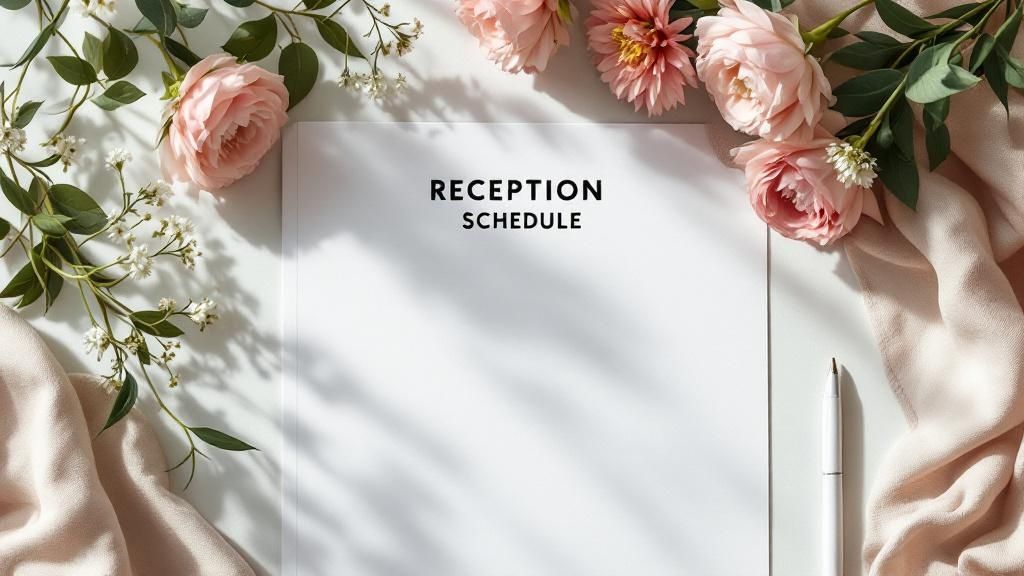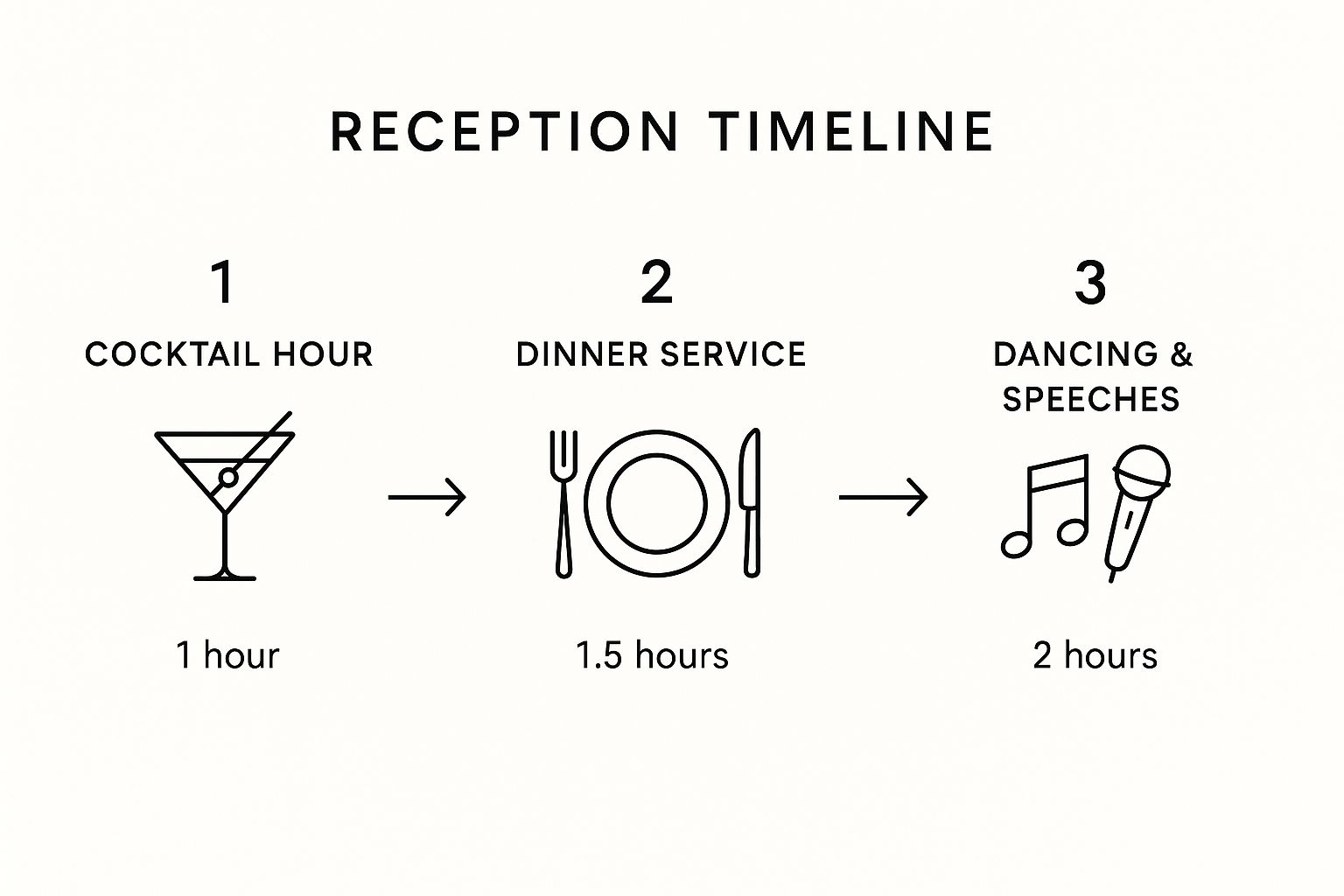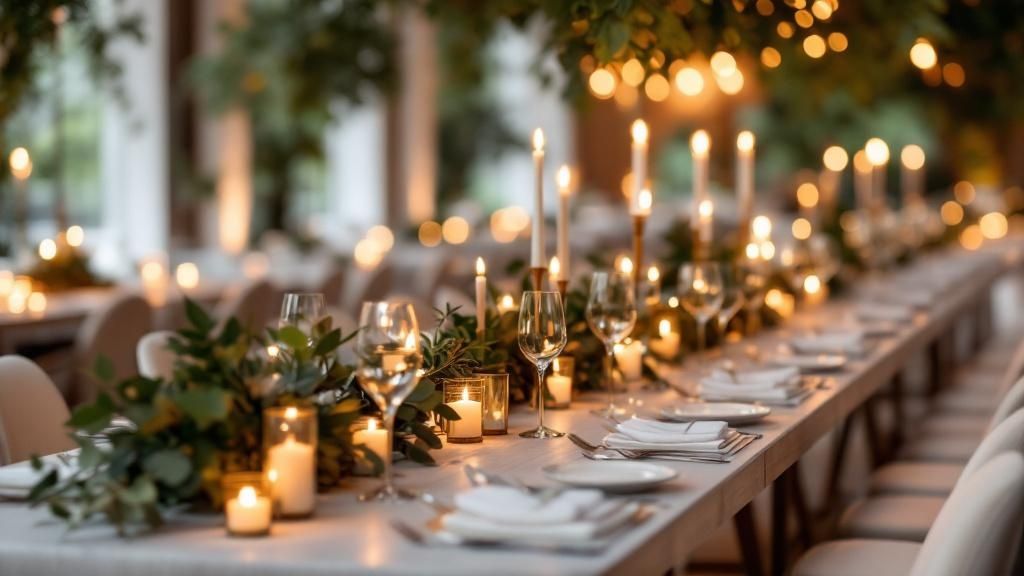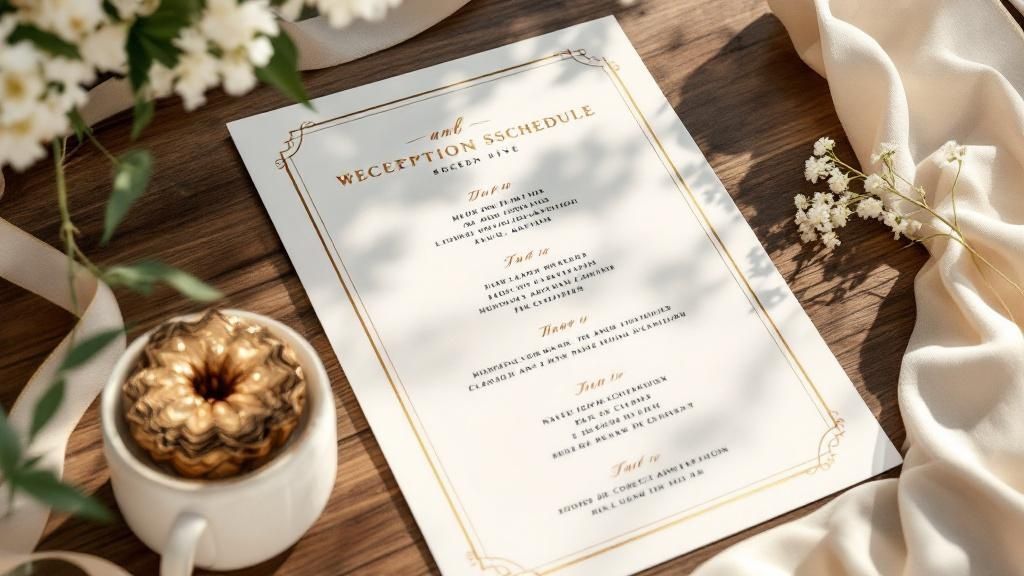A killer wedding reception schedule is the secret ingredient to a smooth, stress-free celebration. Seriously. It’s what turns potential chaos into a beautifully flowing party where you actually get to relax and have fun. Most receptions hover around a five-hour format, which usually breaks down into a one-hour cocktail party followed by four hours of dinner, dancing, and all the good stuff.
Nailing Your Perfect Reception Flow

The key to a genuinely fun, laid-back reception isn't just winging it and hoping for the best—it’s having a great plan. Once you get the "why" behind the traditional order of events, you can confidently tweak, bend, and customize any template to create a day that feels completely you.
Think of your reception timeline as the story of your party. Every part has a purpose, from the warm welcome of cocktail hour to that last, epic dance song.
Breaking Down the Classic Reception
A standard five-hour timeline gives you a solid, time-tested framework. It’s built to perfectly balance mingling, eating, and celebrating so your guests are always engaged and the energy never dips. Here’s how it usually plays out:
-
The Cocktail Hour (First Hour): This is your secret weapon. It acts as a perfect buffer between the ceremony and the main event, giving you and your wedding party a chance to sneak away for photos while your guests grab a drink, enjoy some appetizers, and start mingling.
-
Dinner & Toasts (Next 1.5–2 Hours): Time for the main event. Guests find their seats, the wedding party makes their grand entrance (get that hype music ready!), and dinner is served. I always recommend weaving the speeches between courses—it keeps things moving and holds everyone’s attention.
-
Big Moments & Dancing (Final 2 Hours): This is where the party really kicks into high gear. You'll have your first dance, parent dances, and the cake cutting, leaving plenty of time for everyone to let loose on the dance floor.
Your schedule is more than just a list of times; it's the conductor of your wedding's orchestra. It cues the caterer, signals the DJ, and lets the photographer know exactly where to be for those once-in-a-lifetime shots.
To give you a clearer picture, here’s a sample timeline that you can use as a starting point. Remember, this is just a guide—feel free to adjust the timings to fit your unique plans!
Sample 5-Hour Wedding Reception Timeline
| Time Slot | Event | Duration | Key Action |
|---|---|---|---|
| 6:00 – 7:00 PM | Cocktail Hour | 60 mins | Guests arrive, mingle with drinks & appetizers. Couple takes photos. |
| 7:00 – 7:15 PM | Grand Entrance & Welcome | 15 mins | Wedding party and couple are introduced. Welcome speech by host. |
| 7:15 – 8:15 PM | Dinner Service | 60 mins | First course served. Toasts are often made between courses. |
| 8:15 – 8:30 PM | First Dance & Parent Dances | 15 mins | Couple's first dance, followed by dances with parents. |
| 8:30 – 9:00 PM | Open Dance Floor | 30 mins | DJ/Band kicks off the party and gets guests dancing. |
| 9:00 – 9:15 PM | Cake Cutting | 15 mins | A key photo op! The DJ will announce it to gather guests. |
| 9:15 – 10:45 PM | More Dancing! | 90 mins | The party continues with more music and dancing. |
| 10:45 – 11:00 PM | Last Dance & Grand Exit | 15 mins | The final song is played, leading into the couple's send-off. |
This structure ensures a natural progression from formal moments to a full-on celebration, keeping your guests entertained and the energy high all night.
Looking Beyond the Traditional Timeline
While the five-hour model is a fantastic starting point, don't feel boxed in. Your reception should absolutely reflect your personality, style, and even your cultural background.
Some of the most memorable celebrations I’ve been a part of have broken the mold. For example, some cultures have incredible multi-day festivities. In fact, about a third of Indian weddings involve several days of events, and in France, 45% of weddings stretch across more than one day. Drawing inspiration from different traditions is an amazing way to personalize your celebration.
Whether you're planning a chill Sunday brunch reception or an all-night formal gala, the basic building blocks are the same. The goal is simply to create a logical flow that feels natural, fun, and completely unforced. For a deeper dive, check out this flawless wedding reception timeline guide for even more detailed tips.
Building Your Timeline From Arrival To Grand Exit
Alright, now for the fun part: plugging in all the details that will make your reception truly yours. I always tell my couples to think about the reception in three main chunks: the arrival and cocktail hour, the dinner and speeches, and then the party itself. When you plan each part with purpose, the whole evening just flows beautifully and keeps the energy exactly where you want it.
The Arrival and Cocktail Hour
That first hour is everything—it sets the entire mood for the night. As your guests start filtering in from the ceremony, you want them to immediately feel the vibe. Think music playing, servers with drinks, and some tasty bites making the rounds. This 60-minute cocktail "hour" is the perfect buffer. It lets everyone relax and mingle while you and your wedding party are probably off wrapping up photos.
Here’s a little insider tip: have your photographer sneak into the reception space about 15 minutes before guests are let in. It’s the only chance they’ll get to capture all those gorgeous details—the centerpieces, the place settings, the cake—before the room fills up. You spent months planning it; you deserve those pristine shots!
To get a better sense of how it all connects, take a look at this breakdown.

This visual really simplifies it down to the three core phases of the party, giving you a great starting point for how to block out your time.
Dinner Service and Key Moments
As the cocktail hour starts to wind down, your DJ or MC should gently guide everyone to find their seats. This is the perfect lead-in for your grand entrance, a huge energy booster that officially gets the party started. Set aside about 15 minutes for this.
Dinner service itself will usually take about 90 minutes. Now, here's a piece of advice I give every couple: please don't save all the speeches for one long, post-dinner marathon. It’s a total vibe-killer. Instead, sprinkle them throughout the meal. It works so much better.
For example, you could try a schedule like this:
- Welcome Toast: Kicks things off right after your grand entrance.
- Best Man & Maid of Honor Toasts: Happens after the main course is served.
- Parent Toasts: A sweet moment just before or after dessert.
When you space them out, guests stay way more engaged and you avoid that dreaded post-dinner slump.
Think of your reception's flow like a great story. Your grand entrance is the hook, dinner and toasts build the heartfelt drama, and the open dance floor is the can't-miss climax.
Dancing, Cake, and The Grand Exit
Once dinner plates are cleared and the last toast is made, it's time to hit the dance floor. A really seamless way to do this is to go straight into your first dance, and then maybe follow it up with the parent dances. It's an elegant way to shift the focus from dining to pure celebration.
I always suggest scheduling the cake cutting for about an hour before you plan to leave. Why? Two big reasons:
- It's a huge photo-op you don't want to rush or forget.
- It’s a polite, subtle cue for older guests or those with young kids that the formal parts of the evening are done, giving them a graceful window to head out.
Finally, dedicate a solid 90 minutes to two hours for pure, uninterrupted dancing. This is the heart of the party, so let your band or DJ run with it! To cap off the night perfectly, plan a last dance song to get everyone back on the floor together one last time. Then, it's straight into your grand exit, leaving everyone with an amazing final memory of your incredible day.
Getting Your Wedding Vendors In Sync

That beautiful wedding reception schedule you just put together? It’s not just for you. Think of it as the master plan for your entire vendor team. Every single pro you’ve hired, from the person plating your salad to the one playing your first dance song, depends on this timeline to make magic happen.
Without it, you get chaos. Crossed wires, missed photo ops, and a whole lot of stress you just don't need.
Your timeline is the sheet music for your wedding day orchestra. The DJ, the caterer, the photographer—they’re all incredible musicians on their own. But they need to be playing from the same score to create something truly beautiful. When everyone knows their cue, the whole night just flows. And that means you can actually relax and enjoy it.
The Photographer’s Playbook
Your photographer is chasing moments all night long. Their job is to capture memories that disappear in a flash, so they have to know what's coming next.
Giving them a detailed schedule at least two weeks in advance is a game-changer. They'll want to see the exact times for your grand entrance, the first dance, all the toasts, and the cake cutting. A great photographer uses this timeline to map out their shots, figure out their lighting, and make sure they’re in the perfect spot before the action starts.
It's the difference between getting a stunning, perfectly lit photo of you cutting the cake at 9:00 PM, or a blurry, panicked shot because they were caught off-guard on the other side of the room.
The Caterer And Venue Coordinator
For your catering and venue team, timing isn't just important—it’s everything. These pros run a minute-by-minute operation behind the scenes to make sure the food is hot and the service is flawless.
Here’s what they desperately need to know from your schedule:
- When cocktail hour ends: This is their signal to gently guide guests into the main reception space and get ready for dinner.
- The grand entrance time: The kitchen needs a heads-up so they can fire the first course. A 15-minute delay in your entrance could mean lukewarm soup for 150 guests. Nobody wants that.
- The toast schedule: This is huge. Knowing when speeches are happening prevents a server from clanking down plates right in the middle of your dad’s heartfelt toast.
Your venue coordinator and caterer are the logistical heart of the reception. A clear timeline lets them run the show, solve problems you never even hear about, and keep everything on track so you don't have to think about a thing.
The DJ Or Band Leader
Your DJ or band leader is more than just music; they're the MC for the entire evening. They set the vibe and keep the party moving. Their copy of the schedule is what they'll use to pace the night's energy.
They need to know exactly when to fade the music for toasts, when to announce the first dance, and when to get everyone hyped for the bouquet toss. A DJ who has the timeline can build the energy perfectly, transitioning from mellow dinner tunes to a dance floor that absolutely pops.
Making sure every vendor gets a final copy of this timeline isn't just a good idea—it's essential. This is a task that typically falls to a day-of coordinator. If you’re taking this on yourself, our wedding day-of coordinator checklist is a lifesaver for keeping all these moving parts organized.
Making the Wedding Schedule Your Own
Your wedding is all about you two, and your reception schedule should feel that way, too. Think of any template you find as a rough draft—a good starting point, but the real fun begins when you start tweaking it to match your vibe as a couple. After all, no two love stories are the same, so why should the parties be identical?
Forget being boxed into the classic five-hour evening reception if that’s not your style. Are you morning people who dream of a sun-drenched brunch? Or maybe you're planning an intimate micro-wedding with just your inner circle? Each one of these has a completely different energy and flow. The goal isn't just to be organized; it's to build a timeline that feels authentically you.
How Different Wedding Styles Change the Timeline
Let's get practical about how you can adapt your schedule. A daytime brunch reception, for instance, is a whole different world. The vibe is usually more relaxed, and the timeline might shrink to about three or four hours. Instead of a high-energy DJ set, you might have a live acoustic guitarist, lawn games, and a focus on casual mingling over mimosas.
On the other hand, if you’re having a small micro-wedding, you can pretty much toss the traditional rulebook. With fewer guests, moving from one thing to the next is a breeze. This frees you up to invest more time in personal moments, like a long, cozy dinner where every single guest gets to share a favorite memory of the two of you.
For a large, formal wedding with over 150 guests, precision is everything. You have to be much more strategic to keep things running smoothly, from managing the flow of people to ensuring dinner is served on time. In this scenario, sticking closely to your timeline isn't just a suggestion—it's essential for a seamless experience.
Your reception schedule is your chance to tell your story. Don't be afraid to add personal touches, whether it's a surprise performance, a special cultural tradition, or an interactive activity that gets everyone involved.
What About Destination Weddings?
Planning a wedding somewhere far from home adds a whole new layer of complexity. You're not just throwing a party; you're essentially hosting a mini-vacation for your favorite people. That means your schedule needs to be much more flexible and considerate of the fact that everyone has traveled to be there.
Destination weddings are also getting bigger. The average guest list has climbed to 65 attendees—a five-year high—and these groups have been growing since 2021. When you consider that guests might be spending around $1,300 per couple just on flights, according to these destination wedding statistics, it becomes clear that building in some breathing room is key to a great guest experience.
Here are a few things I always recommend for destination schedules:
- Plan a Welcome Party: A casual welcome dinner or cocktail hour the night before is a fantastic way to let guests settle in and break the ice. It takes the pressure off the main event.
- Build in Downtime: Please, don't overschedule your guests! Give them free time to actually enjoy the destination, whether that means lounging by the pool or exploring the local town.
- Incorporate Local Flavor: Bring in local musicians, serve regional food, or include a cultural tradition from the area. It makes the whole experience feel so much more special and connected to the place you chose.
Whether you're jetting off to a tropical paradise or celebrating right in your hometown, a solid schedule is the backbone of your entire event. For a complete guide on mapping out every single detail, our comprehensive wedding planning timeline is the perfect place to start.
Sidestepping Common Wedding Timeline Snags

Here's a little secret from someone who's seen it all: even the most meticulously planned wedding reception schedule template will face a few bumps. The real magic isn't in creating a perfect plan, but in creating a resilient one. Anticipating the little hiccups is what truly makes for a stress-free day where the party just flows.
The number one mistake I see? Couples don't build in any breathing room. Seriously, buffer time is your best friend. A good rule of thumb is to add a 10-15 minute cushion around any major transition—like getting from the ceremony to the cocktail hour, or from dinner to the first dance.
That little bit of extra time is your timeline’s insurance policy. It covers everything from Aunt Carol getting stuck in traffic to your brother’s toast running a lot longer than he practiced. Without that buffer, one tiny delay snowballs, and suddenly you're feeling the pressure.
Keeping the Vibe and the People Moving
One of the sneakiest timeline killers is bad guest flow. Nothing brings down the energy of a room faster than a huge, slow-moving line for the bar or a chaotic swarm at the buffet. You want to avoid those bottlenecks that make guests antsy and kill the party momentum.
Here are a few tricks I’ve learned over the years:
- Double Up on Drinks: If you have more than 100 guests, a second bar or even just a satellite station with beer and wine is an absolute game-changer.
- Dismiss Tables for Dinner: Instead of a mad dash to the food, have your DJ or MC dismiss tables one by one. It feels organized and keeps things calm.
- Time Your Big Moments: Use your key events to guide the energy. The first dance is a natural way to get everyone on their feet and open the dance floor. Later, the cake cutting can signal that the sweet treats are coming and the night is starting to wind down.
It's interesting how planning styles differ around the world. In the US and UK, couples often plan for over 15 months, while in India, it might be just five or six. As you might guess, those longer engagements often mean bigger, more complex events, which makes a solid, problem-proof schedule non-negotiable. You can read more about these fascinating global wedding trends and see how they shake up the planning process.
The best timelines don't just list events; they anticipate human nature. Building in extra time and managing guest flow isn’t about being rigid—it’s about creating an environment where everyone, especially you, can relax and have fun.
Your Official "Timeline Keeper"
On your wedding day, the last thing you should be doing is clock-watching. This is why you need to hand that job over to someone else. Honestly, this is one of the biggest perks of hiring a professional wedding coordinator. They live and breathe timelines, working behind the scenes with all your vendors to make tiny adjustments so you never even know a problem existed.
If a full-on coordinator isn't in the cards, find your most organized, reliable friend or family member and officially put them in charge. Give them a copy of the timeline and all the vendor phone numbers. Delegating this one task frees you up to actually be present and enjoy the day you worked so hard to plan.
And remember, your timeline should also work hand-in-hand with your ambiance. For instance, think about how the schedule syncs up with your wedding reception lighting choices to create that perfect, magical mood from start to finish.
Answering Your Biggest Wedding Timeline Questions
Even with the best template in hand, you're bound to have questions. That's totally normal! Nailing down the perfect schedule can feel like solving a giant, wonderful puzzle. Let's walk through some of the most common questions I hear from couples. This should give you the clarity and confidence you need to lock in your plans.
How Long Should Our Reception Be?
Most wedding receptions land in the five-hour range. Think of it as a one-hour cocktail "hour" followed by four hours of dinner, dancing, and all the festivities.
But honestly, that’s just a starting point. It's your party! A Sunday brunch wedding might feel just right at three or four hours, while some celebrations, especially for certain cultures or destination weddings, can easily stretch much longer. The goal isn't to hit a specific number, but to make sure you have enough time for everything you care about without feeling like you're in a race against the clock.
When Should We Do The First Dance And Cake Cutting?
Ah, the classic timing dilemma! For the first dance, a popular move is to do it right after your grand entrance. It's an incredible way to kick off the main party. On the flip side, some couples prefer to save it for after dinner, using it as the official signal to open up the dance floor for everyone. There's no wrong answer, just what feels right for you.
When it comes to cutting the cake, a great rule of thumb is to schedule it about an hour before your reception is set to end. Why? It does two things beautifully: it gives older guests a polite cue that it’s okay to head home soon, and it usually happens before your photographer packs up for the night. These are major photo ops, so it's a great idea to chat through these moments with your vendors. Our wedding DJ checklist actually has some great tips for keeping all your pros in sync.
Do We Really Need A Detailed Schedule?
I get it, "go with the flow" sounds so much more fun. But here’s the secret: having a detailed schedule is what allows you to have that carefree, in-the-moment experience on your wedding day.
Think of your timeline as the backstage script that lets you be the star of the show, totally relaxed. Your vendors—especially your caterer, photographer, and DJ—live and breathe by this schedule. It's how they work together to create a seamless event for you and your guests.
A solid timeline ensures the food comes out hot, the photographer is in place for every key moment, and the party flows without a hitch.
How Much Buffer Time Should We Build In?
Adding buffer time might just be the single smartest thing you can do when planning your schedule. Trust me, things almost always take a little longer than you think they will.
A good pro tip is to sprinkle 10-15 minutes of extra time around the big transitions. For example, add a cushion before you move guests from cocktails to dinner, or right before speeches are supposed to start. This little bit of wiggle room prevents one tiny delay from snowballing and keeps the entire evening feeling relaxed and stress-free.
At 1021 Events, we live for this stuff. A perfect timeline is the backbone of an unforgettable party. From a Pro DJ/MC who keeps the energy just right to incredible uplighting and cold sparks that create those "wow" moments, we build our entire performance around your schedule to bring your vision to life.

